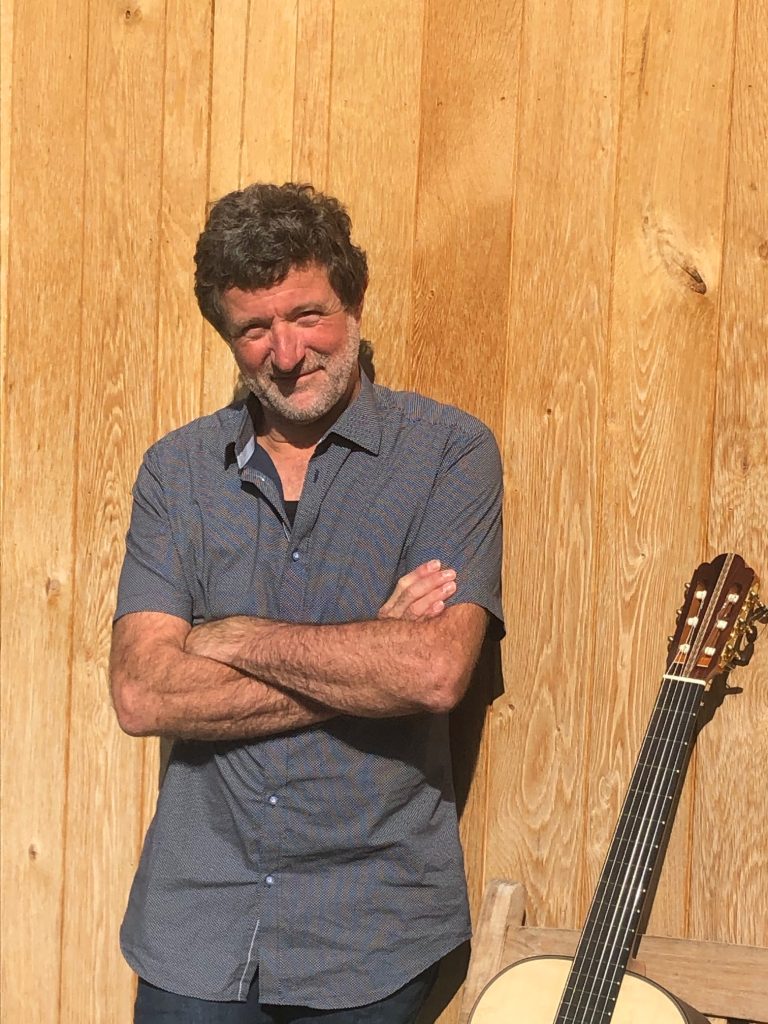
Chitarra Classica – Intervista al liutaio Walter Verreydt (English version below Italian text)
Walter Verreydt è nato a Lier nel 1958.
Dopo gli studi, diventa insegnante di falegnameria e disegno tecnico.
L’amore per la musica è nato nella sua famiglia: il bisnonno Gustave era violinista e insegnante di musica, il nonno Arthur suonava il violoncello e l’organo e il prozio, Edward Verreydt, era un pianista/organista noto, nel periodo tra le due guerre, come compositore di canzoni, musica corale e musica per pianoforte.
Nel 1985, Walter realizza la sua prima chitarra classica: per un appassionato di musica e insegnante di falegnameria, è una logica conseguenza trovare la sua passione nella costruzione di strumenti musicali. Il suo amore per il suono della chitarra classica lo spigne verso la liuteria. Fin dall’inizio, Walter ha avuto la possibilità di studiare alcune bellissime chitarre di famosi liutai come Bouchet, Fleta, Hernandez-Aguado e altri. Ha anche avuto buoni contatti con eminenti liutai come José Romanillos e Daniel Friederich. Ciò ha costituito per lui una ricca fonte di informazioni. A Mittenwald, all’inizio degli anni novanta, durante la selezione dell’abete, Walter conobbe il liutaio tedesco Rolf Eichinger, fu l’inizio di una lunga amicizia. Rolf ha reso Walter più familiare con le tradizioni e le tecniche di fabbricazione della chitarra spagnola durante le sue numerose visite al laboratorio di Rolf a Granada. Queste numerose influenze hanno portato a uno stile molto personale.
Nel 1999, Walter Verreydt è stato il 1° vincitore alla “4a Mostra Concorso Internazionale di Chitarra Classica” a Baveno (It).
Dal 1988 fino a dicembre 2020, Walter insegna la costruzione della chitarra classica al “Centrum voor Muziekinstrumentenbouw” a Puurs (Belgio) www.cmbpuurs.be . Oltre alle necessarie tecniche di base, ha cercato di trasmettere ai suoi studenti l’affinità per la chitarra e per il mestiere. Ha un’attenzione particolare per lo sviluppo di una tecnica efficiente: la lavorazione manuale del legno, le tecniche di piegatura, il disegno e la composizione della rosetta, l’uso corretto delle colle tradizionali e delle tecniche di incollaggio… e naturalmente l’assemblaggio preciso delle diverse parti con attenzione ai dettagli, per la corretta inclinazione del manico della chitarra e tutto ciò che è necessario per uno strumento ben funzionante.
Con i suoi studenti è stato membro attivo del progetto Leonardo Guitar Research (LGR) www.leonardo-guitar-research.com, un progetto incentrato sull’uso di legni sostenibili non tropicali nella costruzione di chitarre acustiche.
Oltre al proprio laboratorio, i corsi sono stati un’attività professionale altrettanto importante per Walter, perché vede la formazione dei giovani liutai, la condivisione e il miglioramento delle conoscenze come una missione importante. In futuro vuole continuare ad organizzare incontri per liutai professionisti oltre a masterclass e corsi speciali di liuteria.
Walter è uno dei fondatori del festival Cordefactum ( www.cordefactum.be ). In questo festival biennale (dal 2004), liutai di diversi paesi sono invitati e riuniti attorno agli strumenti musicali e alla loro costruzione. Nell’ambito del festival vengono organizzate diverse conferenze, workshop, mostre e concerti.
Walter Verreydt utilizza solo i legni migliori, essiccati con cura per molti, che seleziona personalmente in Italia, Spagna, Germania. Il suo metodo di costruzione è ispirato allo stile tradizionale spagnolo e ogni chitarra è il risultato di maestria, passione ed esperienza. I clienti di tutto il mondo apprezzano l’alta qualità e le caratteristiche di questi strumenti unici.
W.M.: Benvenuto su WeeklyMagazine, è con enorme piacere che la contatto. I suoi strumenti sono utilizzati da molti chitarristi sia italiani che non, tra cui il M° Andrea De Vitis che le utilizza nei suoi concerti. Ci racconta dei suoi inizi?
W.V.: Ho sempre avuto una passione per la musica e per la lavorazione del legno. Quando ho iniziato a suonare la chitarra sono rimasto subito affascinato dalla costruzione della chitarra classica e dalle forme estetiche di questo strumento. Molto presto ho iniziato a prendere lezioni al “Centrum voor Muziekinstrumentenbouw”. Questo centro esisteva solo da pochi anni: è stata fondato alla fine degli anni ’70 da alcuni appassionati amanti della costruzione di strumenti musicali. Ma in Belgio non avevamo una vera tradizione nella costruzione di chitarre. Ciò aveva lo svantaggio di non potersi basare sull’esperienza delle vecchie generazioni di liutai, ma d’altro canto era anche molto interessante poter scoprire e sperimentare liberamente e senza inibizioni.
Sono andato alla ricerca di tutti i tipi di informazioni ed ero aperto a provare tecniche e idee da rinomati liutai in Spagna, Francia e Germania e ho inventato il mio stile e il mio concetto. Ma in generale alla fine ho optato per una costruzione tradizionale ‘spagnola’ con l’applicazione delle tecniche e dei materiali associati che hanno dimostrato il loro valore da un punto di vista storico.

W.M.: Tra i grandi liutai del passato quali sono i suoi preferiti?
W.V.: Come per la maggior parte dei liutai, ho un grande apprezzamento per Antonio de Torres. Ogni dettaglio mostra l’opera di un liutaio eccezionale: il design, le proporzioni, l’artigianato, la scelta del legno, la decorazione … e il suono, naturalmente. Riesce a creare una chitarra dalla costruzione molto leggera con un aspetto straordinario e un timbro ricco.
Ho anche una grande affinità con Enrique Garcia. Da liutaio spesso possiamo ‘leggere’ l’artigianalità sullo strumento, su certi piccoli dettagli spesso ammiriamo il ‘virtuosismo’ del costruttore.
W.M.: Tra i modelli storici (Torres, Garcia, Hauser) quale pensa sia il più attuale ed ancora funzionale per i chitarristi di oggi ed il repertorio moderno?
W.V.: Alcune chitarre storiche possono avere una forte personalità, un’individualità, che può renderle più adatte a un certo repertorio, solitamente il repertorio del periodo in cui sono state costruite. Ha senso: come liutaio lavoro per i chitarristi della mia epoca. È attraverso una sana interazione tra costruttore e chitarrista che puoi creare qualcosa di nuovo ed interessante. Il musicista cerca l’oggetto giusto per esprimersi. Il liutaio cerca di fornire queste risorse e di rispondere alle esigenze del musicista. Ma proprio come il repertorio, le esigenze spesso cambiano ed evolvono.
Con strumenti storici e talvolta delicati e dalla forte personalità, è meglio che il chitarrista non forzi lo strumento ma cerchi il metodo e la tecnica esecutiva giusti per far suonare lo strumento in modo spontaneo e libero per esprimere la sua bellezza e il suo timbro.
Per me una Hauser 1 è uno strumento molto più moderno e più in linea con lo standard attuale: è versatile, ricco di timbri e dinamica in tutti i registri e ha un lungo sustain.
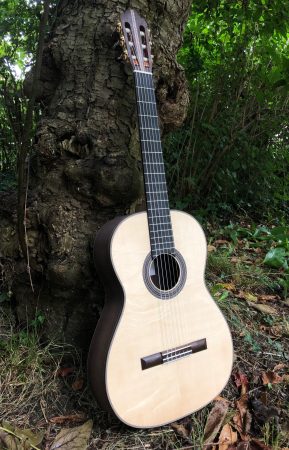
W.M.: Quali sono i modelli di chitarre che costruisce? Preferisce l’abete od il cedro?
W.V.: La mia attuale “chitarra standard” è il frutto di 35 anni di esperienza nella costruzione di chitarre. È un concetto che ho sempre adattato negli anni, in termini di design, costruzione ed estetica. Realizzo questo modello sia in cedro che in abete, con incatenatura lattice ma anche con tradizionale incatenatura a ventaglio. È questo il modello che realizzo principalmente (e che è utilizzato da Andrea De Vitis, Oman Kaminsky, Pablo Garibay, Gaëlle Solal, Pavel Steidl e molti altri).
Preferisco costruire i miei strumenti con un top in abete. È un legno bello e interessante, ma probabilmente non sono molti i chitarristi che si rendono conto che ci sono grandi differenze nella qualità dell’abete che ovviamente hanno una grande influenza sul suono! Come liutaio, si tratta di rilevare e gestire queste qualità per ottenere risultati ottimali.
Ma secondo me anche con il cedro si possono fare ottime chitarre, anche se ci sono liutai che non vogliono assolutamente usarlo. Il cedro è leggero e ben si adatta a certi tipi di chitarra. In generale, si può anche dire che il cedro è meno sensibile all’umidità: condizioni asciutte o umide hanno meno influenza sul suono dello strumento.
Oltre alla mia tipica chitarra Verreydt “standard”, a volte mi piace realizzare repliche esatte o strumenti nello stile di Torres, Garcia, Arias, Manuel Ramirez e Hauser1. Realizzare una replica è una sfida: è importante entrare nella pelle del liutaio originale e cercare di fare esattamente lo stesso, con tecniche e materiali simili, fin nei minimi dettagli. Ogni elemento che cambi può fare la differenza. È enormemente arricchente prendersi di tanto in tanto del tempo per farlo. Ti dà nuove intuizioni e idee che spesso puoi poi applicare alle tue chitarre.
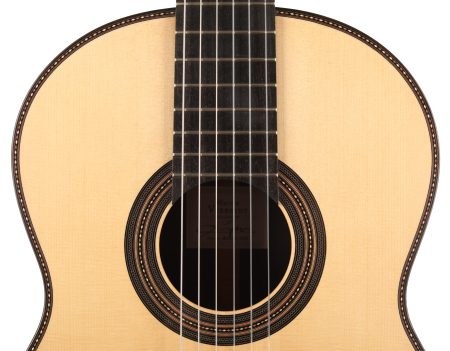
W.M. Per la verniciatura delle chitarre utilizza vernici sintetiche o la gommalacca?
W.V.: Sono convinto che lo gommalacca sia la finitura ideale per una chitarra classica. È una tecnica meravigliosa per la quale in realtà non hai bisogno di molto. La gommalacca viene sciolta in alcool ad almeno 95° e viene quindi applicata con un tampone con movimenti circolari sulla superficie del legno. Dopo qualche tempo, si crea uno strato di lacca estremamente sottile con un’elevata brillantezza che consente al legno di esprimersi particolarmente bene. Poiché è così sottile, non avrà quasi alcun effetto di smorzamento sulla risonanza del legno. Inoltre, una superficie lucida è relativamente facile da ritoccare se necessario, ad esempio dopo aver riparato una crepa nel legno.
Simile è anche l’uso della colla animale (colla a caldo) nelle costruzioni delle chitarre. Fino a qualche decennio fa non esisteva la colla sintetica e tutte le giunzioni in legno erano incollate con colle animali. Questi adesivi possono durare centinaia di anni. Con vecchi mobili e strumenti musicali, le incollature sono ancora intatte dopo decenni. Nella liuteria è impensabile che vengano utilizzati adesivi sintetici nella costruzione, riparazione e restauro di strumenti. D’altra parte, nella costruzione di chitarre, vediamo spesso l’uso di colla sintetica, mentre non sappiamo davvero se questi adesivi possano resistere alla prova del tempo. Inoltre, il legame adesivo è inferiore per vari motivi.
W.M.: Ci può descrivere le caratteristiche di un suo strumento per quanto riguarda il timbro, il volume e la comodità di esecuzione, action, etc.?
W.V.: Prima di tutto, uno strumento deve funzionare correttamente. Ci sono una serie di aspetti tecnici di uno strumento che devono essere corretti. Sto parlando della suonabilità: che richiede un buon profilo del manico, un lavoro preciso sui tasti, una corretta superficie della tastiera con la giusta lunghezza e larghezza di curvatura, l’azione della chitarra, ossa correttamente limate (il capotasto e la selletta), meccaniche ben funzionanti , ecc. Se tutti questi elementi sono stati applicati accuratamente dal liutaio, hai già uno strumento decoroso che viene percepito dal chitarrista come comodo in modo che possa concentrarsi maggiormente sulla musica. Queste sono cose misurabili e quindi controllabili in modo oggettivo. Mi assicuro sempre di farlo perfettamente. Queste sono tutte cose che ho imparato aprendomi ai feedback e ai consigli di molti eccellenti chitarristi che ho incontrato nella mia carriera.
Ovviamente le caratteristiche del suono dei miei strumenti sono più soggettive. Per me è importante che la mia chitarra abbia una bella ‘voce’, ma anche una ricca tavolozza di colori, abbia un bel sustain in tutti i registri e non sia limitata in termini di dinamica. A ogni chitarrista piace avere un buon volume, ma se questa è la prima scelta, va a svantaggio della tavolozza dei colori e il suono diventa noioso rapidamente.
Come liutaio, hai un numero enorme di aspetti con cui puoi influenzare e regolare determinati aspetti. Ci vogliono anni di esperienza per padroneggiare tutto. Ad esempio: lo spessore del tavola armonica, e questo in combinazione con la curvatura, la posizione e lo spessore dell’incatenatura, il modo in cui queste catene sono tagliate e profilate,… e questo vale per ogni parte della chitarra.
E poi ci sono gli aspetti estetici. Si potrebbe dire che l’aspetto della chitarra non è così importante, ma un bellissimo strumento ti invita a suonarci sopra. D’altra parte, l’estetica dello strumento riflette anche il virtuosismo e il fervore del costruttore a rifinire ogni dettaglio alla perfezione.

W.M.: In che modo riesce a bilanciare qualità del suono e proiezione nel suo modello lattice-bracing?
W.V.: Alcune chitarre lattice sono impressionanti nel volume del suono e hanno una dinamica difficile da controllare. Lo si ottiene se lo si applica nel modo più estremo: per esempio, un piano molto leggero con un reticolo estremamente leggero (ad esempio balsa, ‘armato’ di fibre di carbonio) e questo su una cassa armonica piuttosto rigida. Il risultato è una chitarra altamente reattiva.
Uso invece un reticolo su un top (abete o cedro) con uno spessore simile a quello di una chitarra tradizionale. Anche il resto della costruzione è molto tradizionale. Mi dà come risultato una chitarra dinamica con un buon volume e riesco ancora a offrire una ricca tavolozza di colori. Questo compromesso è apprezzato da molti chitarristi.
W.M.: Attualmente quali sono i tempi di attesa di un suo strumento?
W.V.: Attualmente, il tempo di attesa è di circa due anni.
W.M.: Siamo giunti alla fine di questa intervista che gentilmente ha rilasciato per i ns. lettori. La ringrazio per la disponibilità e del contributo che ha fornito allo spazio dedicato alla chitarra classica ed alla liuteria.
W.V.: Grazie mille.
Walter Verreydt was born in Lier in 1958.
After his studies, he became a teacher in woodworking and technical drawing.
The love for music was born into his family: his great-grandfather Gustave was a violinist and music teacher, his grandfather Arthur played the cello and the organ and his great-uncle, Edward Verreydt, was a pianist/organist well-known throughout the Interbellum as a composer of songs, choir music and piano music.
In 1985, Walter made his first classical guitar: as a music lover and woodworking teacher, it was a logical consequence that he found his passion in the construction of musical instruments. His love for the sound of the classical guitar drove him towards guitar making. From the very beginning, Walter has had the possibility to study some beautiful guitars of renowned guitar makers like Bouchet, Fleta, Hernandez-Aguado and others. He also had good contacts with eminent guitar makers like José Romanillos and Daniel Friederich. This formed a rich source of inspiration for him. In Mittenwald, in the beginning of the nineties, while selecting wood, Walter met the German guitar maker Rolf Eichinger, which was the beginning of a long friendship. Rolf introduced Walter to the Spanish guitar making traditions and techniques in his workshop in Granada. These numerous influences have resulted in a very personal style.
In 1999, Walter Verreydt became 1st laureate at the ‘4th Mostra Concorso Internazionale di Chitarra Classica’ in Baveno (It).
From 1988 until December 2020, Walter teaches at the ‘Centrum voor Muziekinstrumentenbouw’ in Puurs (Belgium) www.cmbpuurs.be . Besides the necessary basic techniques, he taught his students affinity for the guitar and for the craft. He has a special attention for the development of an efficient technique: the manual processing of the wood, the bending techniques, the design and the composition of the marquetry and the rosette, the correct use of traditional glues and gluing techniques… and of course the precise assembly of the different parts with attention for detail, for the correct inclination of the guitar’s neck and everything that is necessary for a well-functioning instrument.
With his students he was an active member of the Leonardo Guitar Research (LGR) Project www.leonardo-guitar-research.com, a project with focus on the use of sustainable non-tropical woods in acoustic guitar making.
Apart from his own workshop, the courses were an equally important professional activity for Walter, because he sees the education of young guitar makers and the sharing and improving of knowledge as an important mission. In the future he wants to continue to organize meetings for professional luthiers and as well as masterclasses and special guitar making courses.
Walter is one of the founders of the Cordefactum festival ( www.cordefactum.be ). On this biennal festival (since 2004), luthiers from different countries are invited and reunited around musical instruments and their construction. Within the context of the festival, different lectures, workshops, expositions and concerts are organized.Walter Verreydt uses only the best woods which are selected in Italy, Spain, Germany, … and dried during many years with care. The construction method is inspired by the traditional Spanish style and every guitar is the result of craftmanship, passion and experience. Customers all over the world appreciate the high quality and characteristics of this instruments.
Walters’ guitars are used by excellent guitar players and on numerous international guitars competitions they have won prices.
W.M . : Welcome to the WeeklyMagazine page, it is with great pleasure that I contact you. His instruments are used by many Italian and non-Italian guitarists. I recently had the opportunity to discuss with Maestro Andrea De Vitis who is a happy owner of some of his precious instruments that he uses for his concerts. Can you tell us about your beginnings?
W.V.: I have always had a passion for music and for woodworking. When I started playing guitar I was immediately fascinated by the construction of the classical guitar and charmed by the aesthetic shapes of this instrument. Very soon I started taking lessons at the ‘Centrum voor Muziekinstrumentenbouw’. It only existed for a few years: it was founded in the late 70s by some enthusiastic lovers of musical instrument making. But in Belgium we didn’t really have a tradition in guitar making. That had the disadvantage that we could not build on the experience of older generations of luthier, but on the other hand it was also very interesting to be able to discover and experiment freely and uninhibitedly.
I went looking for all kinds of information and was open to try techniques and ideas from reputed guitar makers in Spain, France and Germany and came up with my own style and concept. But in general I ultimately opted for a traditional ‘Spanish’ construction with the application of the associated techniques and materials that have proven their value from a historical point of view.
W.M . : Which are your favourites among the great luthiers of the past?
W.V .: As like for most guitar makers, there is a great appreciation for Antonio de Torres. Every detail shows that it was very special: the design, the proportions, the craftsmanship, the choice of wood, the decoration, … and the sound of course. He succeeds in building a guitar with a very light construction with an enormous appearance and a rich timbre.
I also have a great affinity for Enrique Garcia. As a luthier we can often ‘read’ the craftsmanship on the instrument, on certain small details we often admire the ‘virtuosity’ of the builder.
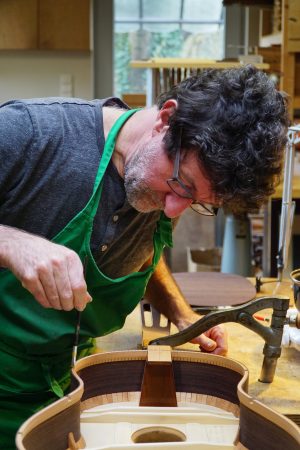
W.M .: Among the historical models (Torres, Garcia, Hauser) which do you think is the most current and still functional for today’s guitarists and the modern repertoire?
W.V .: Some historical guitars can have a strong personality, an individuality, which may make them more suitable to a certain repertoire, usually the repertoire from the period in which they were built. That makes sense: as a luthier you work for guitarists from your era. It is through a healthy interaction between builder and guitarist that you can create something new and interesting. The musician looks for the right object to express himself. The luthier tries to provide these resources and to respond to the needs of the musician. But just like the repertoire, the needs often change and evolve.
With historical and sometimes delicate instruments with a strong personality, it is better that the guitarist does not force the instrument but looks for the right playing method and technique to make the instrument sound spontaneous and free in all its beauty and timbre.
For me, a Hauser 1 is a much more modern instrument that is more in line with the current standard: it is versatile, rich in timbre and dynamics in all registers and has a long sustain.
W.M .: What are the guitars you build? Do you prefer spruce or cedar?
W.V . : My current ‘standard guitar’ is the fruit of 35 years of experience in guitar making. It is a concept that I have always adjusted over the years, in terms of design, construction and aesthetics. I make this model both in cedar and in spruce, with lattice bracing and with traditional fan bracing. It is this model I mostly make (and which is played by Andrea De Vitis, Oman Kaminsky, Pablo Garibay, Gaëlle Solal, Pavel Steidl and many others).
I prefer to construct my instruments with a spruce top. It is a beautiful and interesting wood, but probably there are not many guitarists who realize that there are big differences in the quality of spruce that obviously have a huge influence on the sound! As a guitar maker, it is all about detecting and managing these qualities in order to achieve optimal results.
But in my opinion, also with cedar you can make excellent guitars, although there are guitar makers who absolutely don’t want to use it. Cedar is light and well suitable to certain types of guitar. In general, you can also say that cedar is less sensitive to humidity: Dry or humid conditions have less influence on the sound of the instrument.
In addition to my typical ‘standard’ Verreydt guitar, I sometimes like to make exact replicas or instruments in the style of Torres, Garcia, Arias, Manuel Ramirez and Hauser1. Making a replica is a challenge: it is important that you get into the skin of the original instrument maker, and that you try to do exactly the same, with similar techniques and materials, down to the smallest detail. Every element you change can make a difference. It is enormously enriching to take occasionally the time to do that. It gives you new insights and ideas and often you will take over certain things and apply them to your own guitars.
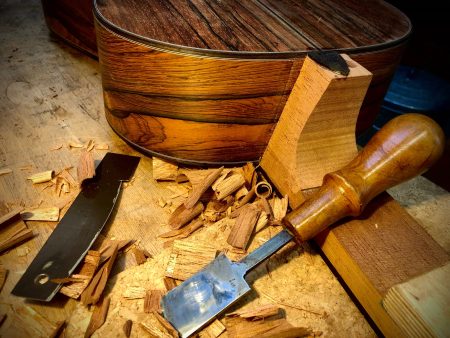
W.M. Do you use synthetic varnish or shellac to paint your guitars?
W.V .: I am convinced that French polish is the most ideal finish for a classical guitar. It is a wonderful technique for which you actually don’t need very much. Shellac is dissolved in alcohol of at least 95° and is then applied with a tampon in circular movements over the wood surface. After some time, an extremely thin lacquer layer with a high gloss is created that allows the wood to come into its own particularly well. Because it is so thin, it will also have almost no dampening effect on the resonation of the wood. In addition, a polish surface is relatively easy to repair if necessary, for example after repairing a crack in the wood.
Similar is also the use of animal glue (hot glue or hide glue) in guitar constructions. Until a few decades ago, there was no synthetic glue and all wood joints were glued with animal glues. These adhesives can last hundreds of years. With old furniture and musical instruments, the glue seams are still intact after decades. In violin making, it is unthinkable that synthetic adhesives would be used in the construction and repair and restoration of instruments. On the other hand, in guitar making, we often see the use of synthetic glue, while we do not really know whether these adhesives can stand the test of time. In addition, the adhesive bond is inferior for various reasons.
W.M .: Can you describe the characteristics of one of your instruments in terms of timbre, volume and ease of execution, action, etc.?
W.V .: First and foremost, an instrument must function properly. There are a number of technical aspects to an instrument that need to be right. I’m talking about playability: that requires a good neck profile, precise fret work, correct fingerboard surface with the right length and width curving, the action of the guitar, properly filed bones (the nut and the saddle), well-functioning tuners, etc. If all these elements have been accurately applied by the guitar maker, you already have a decent instrument that is experienced by the guitarist as comfortable so that he can concentrate more on the music. These are measurable things and can therefore be checked in an objective way. I always make sure I do this perfectly. These are all things I’ve learned by being open to the feedback and advice of many excellent guitarists I’ve met in my career.
Of course, the characteristics of the sound of my instruments are more subjective. For me it is important that my guitar has a beautiful ‘voice’, but also a rich palette of colours, has a nice sustain in all registers and is not limited in terms of dynamics. Every guitarist likes to have a good volume, but if this is the first choice, it is at the disadvantage of the colour palette and the sound gets boring quickly.
As a guitar maker, you have a huge number of aspects with which you can influence and adjust certain things. It takes years of experience to master it all. For example: the thickness of the top, and this in combination with the curving, the position and the thickness of the bracing, the way in which these bracing are profiled and cut,… and this apply for each part of the guitar.
And then there are the aesthetic aspects. You could say that the appearance of the guitar is not that important, but a beautiful instrument invites you to play on it. On the other hand, the aesthetic of the instrument also reflects the virtuosity and drive of the maker to finish every detail to perfection.
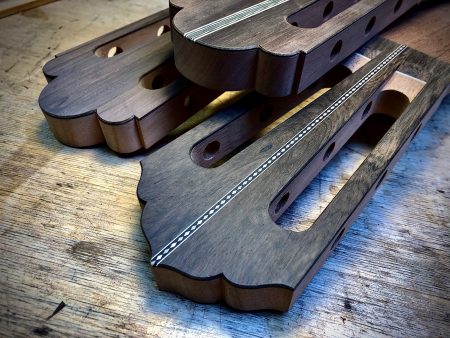
W.M .: How do you manage to balance sound quality and projection in your lattice-bracing model?
W.V .: Some lattice guitars are impressive in sound volume and have a dynamics that are difficult to control. You get this if you apply it in its most extreme way: for example, a very light top with an extremely light lattice (for example balsa, ‘armed’ with carbon fibres) and this on a pretty rigid sound box. It results in a highly reactive guitar.
Instead, I use a lattice on a top (spruce or cedar) with a thickness similar to a traditional guitar. The rest of the construction is also very traditionally. It gives me as a result a dynamic guitar with a good volume and I still manage to offer a rich colour palette. This compromise is appreciated by many guitarists.
W.M .: What are the waiting times for one of your instruments at the moment?
W.V .: Currently, the waiting time is about two years.
W.M .: We have reached the end of this interview that you kindly gave for our readers. Thank you for your availability and for the contribution you have provided to the space dedicated to classical guitar and lutherie.
W.V .: Thank you very much.
